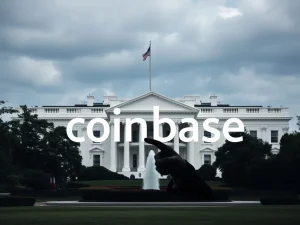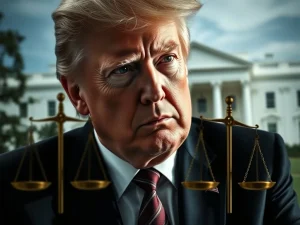Crucial Crypto Voters Poised to Impact US Midterms: A Deep Dive into 2026 Election Influence

The political landscape of the United States is constantly shifting. A recent poll suggests that crypto voters could significantly alter the dynamics of the upcoming US midterms. This insight highlights a growing trend: the increasing political relevance of digital assets. The findings indicate a notable potential for election influence by a demographic increasingly concerned with cryptocurrency policies. This article explores how pro-crypto candidates are gaining traction and what this means for the 2026 elections.
The Rising Power of Crypto Voters in US Midterms
A new survey, conducted by McLaughlin and Associates, underscores the substantial impact that digital asset issues may have on the 2026 US midterms. The poll results, released by the Digital Chamber, reveal a compelling trend. A significant majority of respondents, 64% of 800 individuals surveyed, consider a candidate’s stance on cryptocurrency “very important” when deciding their vote. This indicates a powerful new voting bloc.
Furthermore, this emerging political force shows a willingness to cross party lines. While 38% of respondents identified as Democrats, a striking 37% expressed greater trust in Republican candidates to advance favorable crypto policies. This particular shift could prove decisive in tight races. The Digital Chamber emphasized this point: “As redistricting continues to reshape safe districts into tighter races next year, the midterms could be decided by just a few votes.” Consequently, politicians are taking notice.
This data suggests that legislative action on major crypto issues could sway a considerable number of voters. Policies addressing digital asset market structure, a federal strategic Bitcoin reserve, or even anti-CBDC legislation are gaining traction. Such initiatives directly appeal to this growing segment of crypto voters. Therefore, understanding these voter preferences becomes paramount for any aspiring candidate.
Understanding Digital Assets and Election Influence
The concept of digital assets encompasses a broad range of technologies. These include cryptocurrencies like Bitcoin and Ethereum, stablecoins, and NFTs. The regulatory environment surrounding these assets remains a key concern for many. Voters are increasingly looking for clear, supportive frameworks. Consequently, candidates who articulate a well-defined position on crypto often gain an advantage. The perceived lack of regulatory clarity has been a consistent complaint within the crypto community.
Historically, the 2024 US elections provided a preview of this phenomenon. Many prominent figures in the crypto and blockchain industry actively endorsed candidates. Advocacy groups and Political Action Committees (PACs) worked diligently. They aimed to steer voters towards what they deemed pro-crypto candidates. The results were tangible: approximately 270 lawmakers with favorable views on digital assets now serve in the US Congress, according to the Coinbase-affiliated group Stand With Crypto. This momentum suggests a growing bipartisan recognition of crypto’s importance.
The **election influence** of the crypto industry is not merely theoretical; it is backed by significant financial contributions and organized advocacy. This strategic engagement seeks to shape policy outcomes that foster innovation and protect investor interests. Ultimately, the industry aims for a regulatory environment that supports, rather than stifles, growth.
The Role of Pro-Crypto Candidates and Political Action Committees
Even though 2025 features fewer elections than the critical 2026 cycle, early indicators suggest a continued trend. Money from the crypto industry has already influenced several races. For instance, Protect Progress, a crypto-aligned PAC associated with Fairshake, committed over $1 million to support Democrat James Walkinshaw. Walkinshaw successfully won a primary for a House seat representing Virginia’s 11th congressional district in September. This early investment highlights strategic targeting.
Similarly, Defend American Jobs, another Fairshake affiliate, spent more than $1.5 million. This funding supported candidates in elections for two Florida House seats. Both Republicans, Jimmy Patronis and Randy Fine, emerged victorious in their special elections held in April. These examples illustrate the effective deployment of resources by crypto PACs. They actively seek to bolster pro-crypto candidates across the political spectrum.
The question of whether the industry will match or exceed its 2024 spending in the 2026 US midterms remains open. However, major players like Coinbase have already contributed millions of dollars to Fairshake. This signals a sustained commitment to political engagement. The stakes are high, as the outcome of these elections could significantly alter the balance of power in Congress. This could, in turn, shape the future of digital asset regulation for years to come.
Legislative Priorities for Digital Assets
The poll findings clearly indicate that voters prioritize specific legislative actions concerning digital assets. These key areas include:
- Digital Asset Market Structure Legislation: This aims to create clear rules for how cryptocurrencies and other digital assets are traded, custodied, and regulated. A well-defined structure could foster innovation while protecting consumers.
- Federal Strategic Bitcoin Reserve: Some advocate for the US government to hold Bitcoin as a strategic asset. Proponents believe this could strengthen national financial security and embrace emerging technologies.
- Anti-CBDC Legislation: Central Bank Digital Currencies (CBDCs) are a contentious topic. Many crypto advocates oppose their implementation, fearing they could lead to increased government surveillance and reduced financial privacy.
These policy positions resonate deeply with the crypto community. Candidates who champion these causes are more likely to earn the trust and votes of this influential demographic. Therefore, politicians are carefully crafting their platforms to address these concerns. The debate surrounding these issues will undoubtedly intensify as the 2026 elections draw nearer.
The Future of Election Influence and Crypto Policy
The burgeoning influence of crypto voters marks a significant shift in American politics. As the 2026 US midterms approach, the industry’s ability to exert **election influence** will be closely watched. The increasing engagement of PACs and major crypto entities underscores a strategic, long-term effort to shape policy. This effort aims to create a more favorable regulatory environment for digital assets.
The potential for a relatively small, yet highly motivated, group of voters to sway elections is powerful. This dynamic encourages both Democratic and Republican parties to develop comprehensive stances on cryptocurrency. Ultimately, the success of pro-crypto candidates will hinge on their ability to connect with these voters. They must effectively articulate policies that support innovation and address community concerns. The coming years will undoubtedly showcase the growing political might of the cryptocurrency ecosystem.








